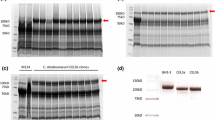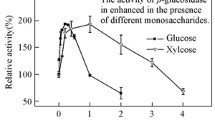Abstract
Ten putative Trichoderma reesei β-glucosidase (BGL) isozymes were heterologously expressed in Escherichia coli and Aspergillus oryzae and purified to homogeneity. Catalytic properties of nine enzymes which showed hydrolytic activity on cellobiose and p-nitrophenyl-β-D-glucopyranoside (pNPG) were investigated. Three BGLs, encoded by the genes cel3A, cel3B, and cel3E, contained a predicted signal peptide, showed higher hydrolytic activity on cello-oligosaccharides than on pNPG, and preferred longer oligosaccharides. Another three putative extracellular BGLs, Cel3B, Cel3F, and Cel3G, and two intracellular enzymes, Cel3C and Cel3D, exhibited preference for pNPG. Intracellular Cel1A showed the highest affinity for cellobiose as a typical cellobiase. Four BGLs, Cel3A, Cel3B, Cel3E, Cel1A, that showed high activity against cello-oligosaccharides were capable of catalyzing transglycosylation reactions from cellobiose, leading to formation of cellotriose and isomeric glucobioses. While Cel3A, Cel3B, and Cel3E synthesized mainly gentiobiose, glycosyl transfer reactions of Cel1A led mainly to sophorose and laminaribiose. Conversion of cellobiose to sophorose by Cel1A reached about 3.6 and 10 % at 1 and 10 % cellobiose concentration, respectively. The formation and persistence of individual cellobiose isomers in incubation mixtures of four BGLs (Cel3A, Cel3B, Cel3E, and Cel1A) with cellobiose correlated well with the k cat values for isomeric glucobioses. Cel1A also showed the lowest sensitivity to inhibition by glucose. Based on all studied catalytic properties, Cel1A appears to be unambiguously the best candidate for site-directed mutations or directed evolution toward improvement of activity, thermostability, and, eventually, efficiency of sophorose synthesis.




Similar content being viewed by others
References
Cantarel BL, Coutinho PM, Rancurel C, Bernard T, Lombard V, Henrissat B (2009) The carbohydrate-active EnZymes database (CAZy): an expert resource for glycogenomics. Nucleic Acids Res 37:D233–D238
Castro S, Pedersoli WR, Cristina A, Antoniêto C, Steindorff AS, Silva-Rocha R, Martinez-Rossi NM, Rossi A, Brown NA, Goldman GH, Faça VM, Persinoti GF, Silva RN (2014) Comparative metabolism of cellulose, sophorose and glucose in Trichoderma reesei using high-throughput genomic and proteomic analyses. Biotechnol Biofuels 7:41. doi:10.1186/1754-6834-7-41
Foreman PK, Brown D, Dankmeyer L, Dean R, Diener S, Dunn-Coleman NS, Goedegebuur F, Houfek TD, England GJ, Kelley AS, Meerman HJ, Mitchell T, Mitchinson C, Olivares HA, Teunissen PJ, Yao J, Ward M (2003) Transcriptional regulation of biomass-degrading enzymes in the filamentous fungus Trichoderma reesei. J Biol Chem 278:31988–31997
Fowler T, Brown RD Jr (1992) The bgl1 gene encoding extracellular β-glucosidase from Trichoderma reesei is required for rapid induction of the cellulase complex. Mol Microbiol 6:3225–3235
Gomi K, Iimura Y, Hara S (1987) Integrative transformation of Aspergillus oryzae with a plasmid containing the Aspergillus nidulans argB gene. Agric Biol Chem 51:2549–2555
Gomi K, Akeno T, Minetoki T, Ozeki K, Kumagai C, Okazaki N, Iimura Y (2000) Molecular cloning and characterization of a transcriptional activator gene, amyR, involved in the amylolytic gene expression in Aspergillus oryzae. Biosci Biotechnol Biochem 64:816–827
Henrissat B, Bairoch A (1993) New families in the classification of glycosyl hydrolases based on amino acid sequence similarities. Biochem J 293:781–788
Häkkinen M, Arvas M, Oja M, Aro N, Penttilä M, Saloheimo M, Pakula TM (2012) Re-annotation of the CAZy genes of Trichoderma reesei and transcription in the presence of lignocellulosic substrates. Microb Cell Factories 11:134–160
Kovács K, Szakacs G, Zacchi G (2009) Comparative enzymatic hydrolysis of pretreated spruce by supernatants, whole fermentation broths and washed mycelia of Trichoderma reesei and Trichoderma atroviride. Biores Technol 100:1350–1357
Lineweaver H, Burk D (1934) The determination of enzyme dissociation constants. Am Chem Soc 56:658–666
Lowry OH, Rosebrough NJ, Farr L, Randall RJ (1951) Protein measurement with folin phenol reagent. Biol Chem 193:265–275
Mach RL, Seiboth B, Myasnikov A, Gonzalez R, Strauss J, Harkki AM, Kubicek CP (1995) The bgl1 gene of Trichoderma reesei QM 9414 encodes an extracellular, cellulose-inducible β-glucosidase involved in cellulase induction by sophorose. Mol Microbiol 16:687–697
Mandels M, Parrish FW, Reese ET (1962) Sophorose as an inducer of cellulase in Trichoderma viride. J Bacteriol 83:400–408
Mandels M, Reese ET (1960) Induction of cellulase in fungi by cellobiose. J Bacteriol 79:816–826
Nakatani Y, Lamont IL, Cutfield JF (2010) Discovery and characterization of a distinctive exo-1, 3/1, 4-β-glucanase from the marine bacterium pseudoalteromona ssp. Strain BB1. Appl Environ Microbiol 76:6760–6768
Nisizawa T, Suzuki H, Nisizawa K (1971) “De novo” synthesis of cellulase induced by sophorose in Trichoderma viride cells. Biochem 70:387–393
Reese ET (1976) History of the cellulase program at the U.S. army natick development center. Biotechnol Bioeng Symp 6:9–20
Saloheimo M, Kuja-Panula J, Ylösmäki E, Ward M, Penttilä M (2002) Enzymatic properties and intracellular localization of the novel Trichoderma reesei β-glucosidase BGLII (Cel1A). Appl Environ Microbiol 68:4546–4553
Shida Y, Yamaguchi K, Nitta M, Nakamura A, Takahashi M, Kidokoro S, Mori K, Tashiro K, Kuhara S, Matsuzawa T, Yaoi K, Sakamoto Y, Tanaka N, Mirokawa Y, Ogasawara W (2015) The impact of a single mutation of bgl2 on cellulose induction in a Trichoderma reesei mutant. Biotechnol Biofuels 8:230
Sternberg D, Mandels GR (1979) Induction of cellulolytic enzymes in Trichoderma reesei by sophorose. J Bacteriol 139:761–769
Teeri TT, Koivula A, Linder M, Wohlfahrt G, Divne C, Jones TA (1998) Trichoderma reesei cellobiohydrolases: why so efficient on crystalline cellulose? Biochem Soc Trans 26:173–178
Tiwari P, Misra BN (2013) Sangwan NS (2013) β-glucosidases from the fungus Trichoderma: an efficient cellulase machinery in biotechnological applications. Biomed Res Int 203735. doi:10.1155/2013/203735
Vaheri MP, Leisola M, Kauppinen V (1979a) Transglycosylation products of cellulase system of Trichoderma reesei. Biotechnol Lett 1:41–46
Vaheri MP, Vaheri MEO, Kauppine VS (1979b) Formation and release of cellulolytic enzymes during growth of Trichoderma reesei on cellobiose and glycerol. Appl Microbiol Biotechnol 8:73–80
Xu J, Zhao G, Kou Y, Zhang W, Zhou Q, Chen G, Liu W (2014) Intracellular β-glucosidases CEL1a and CEL1b are essential for cellulase induction on lactose in Trichoderma reesei. Eukaryotic Cell 13:1001–1013
Zhou Q, Xu J, Kou Y, Lv X, Zhang X, Zhao G, Zhang W, Chen G, Liu W (2012) Differential involvement of β-glucosidases from Hypocrea jecorina in rapid induction of cellulase genes by cellulose and cellobiose. Eukaryot Cell 11:1371–1381
Zhang W, Kou Y, Xu J, Cao Y, Zhao G, Shao J, Wang H, Wang Z, Bao X, Chen G, Liu W (2013) Two major facilitator superfamily sugar transporters from Trichoderma reesei and their roles in induction of cellulase biosynthesis. J Biol Chem. doi:10.1074/jbc.M113.505826
Author information
Authors and Affiliations
Corresponding author
Ethics declarations
This article does not contain any studies with human participants or animals performed by any of the authors.
Funding
This study was funded by Grant-in-Aid for the Global COE Program by the Ministry of Education, Culture, Sports, Science and Technology of Japan and was also sponsored by New Energy and Industrial Technology Development Organization (NEDO).
Conflict of interest
The authors declare that there are no conflicts of interest.
Electronic supplementary material
ESM 1
(PDF 331 kb)
Rights and permissions
About this article
Cite this article
Guo, B., Sato, N., Biely, P. et al. Comparison of catalytic properties of multiple β-glucosidases of Trichoderma reesei . Appl Microbiol Biotechnol 100, 4959–4968 (2016). https://doi.org/10.1007/s00253-016-7342-x
Received:
Revised:
Accepted:
Published:
Issue Date:
DOI: https://doi.org/10.1007/s00253-016-7342-x




